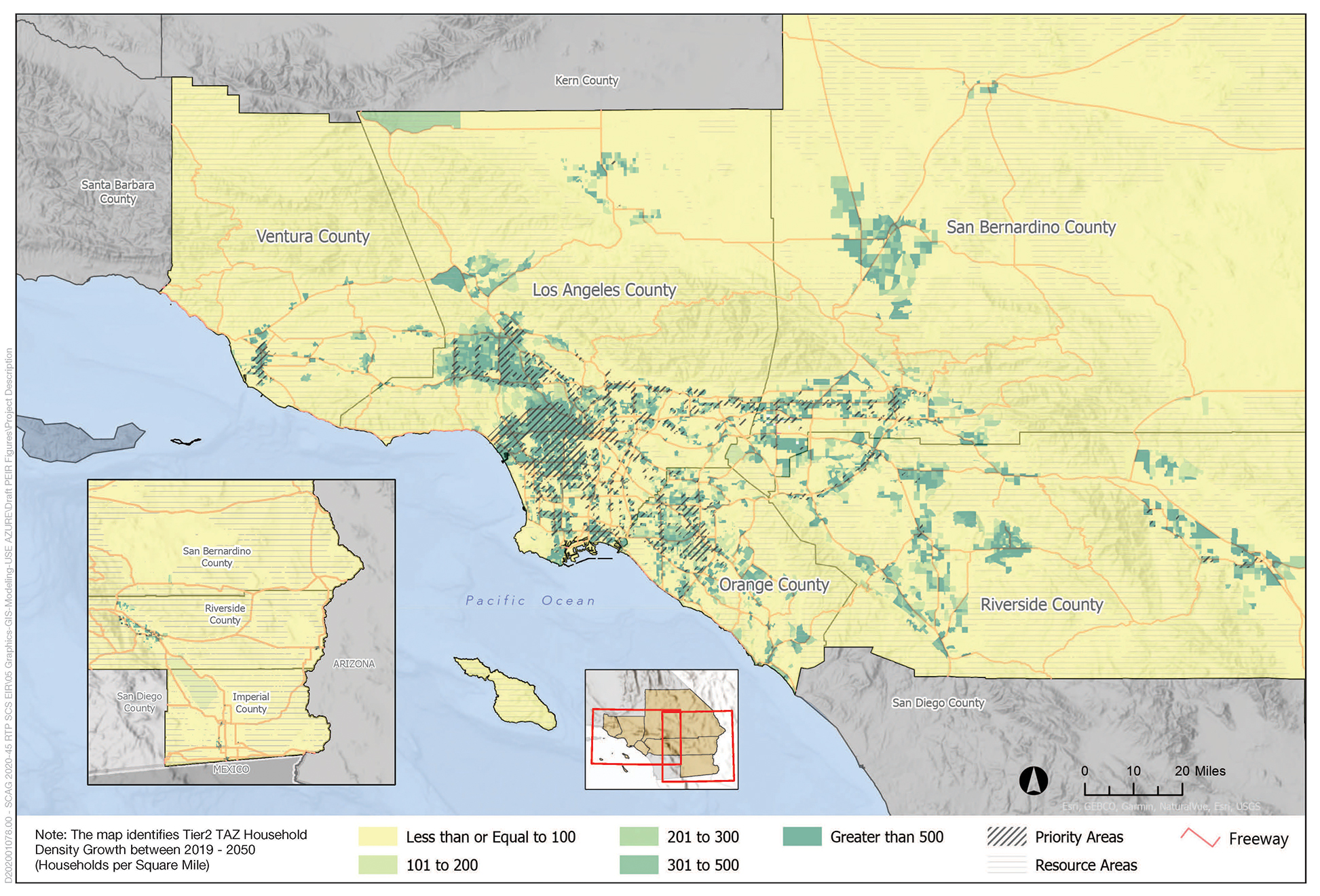To protect critical ecosystems and water supplies amid growing climate and regulatory pressures, ESA partners...

SCAG 2024-2050 Regional Transportation Plan/Sustainable Communities Strategy
The 2024–2050 Regional Transportation Plan/Sustainable Communities Strategy (Connect SoCal 2024) outlines the development and management of an integrated, intermodal transportation network for the SCAG metropolitan area. The Plan and its Program Environmental Impact Report (PEIR) present a vision for a resilient, equitable future with strategies and investments to achieve regional goals by 2050.
Why does this project matter?
As the Metropolitan Planning Organization (MPO) for the region, SCAG is required by federal law (23 U.S.C. Section 134 et seq.) to prepare and update a long-range Regional Transportation Plan (RTP) every four years. The Plan must provide for the development, integrated management, and operation of transportation systems and facilities that will function as an intermodal transportation network for the SCAG metropolitan planning area.
In addition, the passage of California Senate Bill 375 (SB 375) in 2008 requires that SCAG prepare and adopt a Sustainable Communities Strategy (SCS) that sets forth a forecasted regional development pattern that, when integrated with the transportation network as well as measures and policies, will reduce greenhouse gas (GHG) emissions from automobiles and light-duty trucks and achieve the GHG emissions reduction target for the region set by the California Air Resources Board (Govt. Code Section 65080(b)(2)(B)). Additionally, the focus on equity in the Plan supports compliance with Title VI of the Civil Rights Act of 1964 and Environmental Justice guidance at the state and federal levels.
What is ESA doing to help?
The 2024–2050 RTP/SCS and subsequent PEIR represent the culmination of four years of work by SCAG regional planning staff and the ESA team, and its subconsultant team that included Sirius Environmental (Sirius) and Terry Hayes and Associates (TAHA). The planning process involved rigorous technical analysis, extensive stakeholder engagement, and robust policy discussions with local elected leaders.
 The 2024 PEIR built upon the 2020 PEIR prepared for the prior cycle of Connect SoCal and addressed the full suite of California Environmental Quality Act (CEQA) Guidelines Appendix G Initial Study Checklist issues and thresholds as part of the analysis. Through early stakeholder engagement, including specific outreach to and consultation with the Ventura County Air Pollution Control District and South Coast Air Quality Management District, evaluation of key environmental concerns raised in the prior cycle 2020 Plan and PEIR, and thorough consideration of public and agency comments submitted in response to the Notice of Preparation, the 2024 PEIR and its underlying analyses provide a comprehensive analysis of the potential effects of implementation of the Plan’s listed transportation projects.
The 2024 PEIR built upon the 2020 PEIR prepared for the prior cycle of Connect SoCal and addressed the full suite of California Environmental Quality Act (CEQA) Guidelines Appendix G Initial Study Checklist issues and thresholds as part of the analysis. Through early stakeholder engagement, including specific outreach to and consultation with the Ventura County Air Pollution Control District and South Coast Air Quality Management District, evaluation of key environmental concerns raised in the prior cycle 2020 Plan and PEIR, and thorough consideration of public and agency comments submitted in response to the Notice of Preparation, the 2024 PEIR and its underlying analyses provide a comprehensive analysis of the potential effects of implementation of the Plan’s listed transportation projects.
It also considers the effects resulting from urban development, consistent with the Plan’s forecasted regional development pattern, regional planning policies, and implementation strategies. The 2024 PEIR included SCAG mitigation measures to address regional impacts and project-level mitigation measures to be adopted and implemented by local agencies in the region, as applicable, for future transportation and urban development projects within their respective jurisdictions.
The SCAG Regional Council adopted the 2024–2050 RTP/SCS and certified the associated PEIR in April 2024.
Connect with our team
“This was an amazing team, and while we always have twists and turns, I always knew I could count on ESA to overcome any obstacle. I truly appreciate all your hard work and dedication to the success of this project...this has honestly been one of the easiest cycles for us—and that is in large part thanks to the commitment and dedication of this team!”
Details
Location Southern California
Market Community Development
Services
Planning
Aviation Noise
Community Planning & Design
Noise & Vibration
Geospatial
Environmental Review & Documentation
California Environmental Quality Act (CEQA)
Agency Consultation & Coordination
Air Quality
Greenhouse Gas Mitigation
Biological Resources
Land & Resource Management
Cultural & Historic Resources
Archaeology
Historic Preservation

The forecasted regional development pattern in Ventura, Los Angeles, San Bernardino, Riverside, Imperial, and Orange counties was assessed by the PEIR.
News & Ideas
ESA is pleased to announce the appointment of new practice leaders to oversee two of...
ESA is thrilled to announce the promotion of Autumn Ward to the role of Airports...
In our industry, we must consider compliance with the federal Endangered Species Act (FESA) when...
How the Supreme Court narrowed the consideration of indirect and cumulative effects under NEPA. The...
This is the second in a series of articles exploring how ESA is working with...







